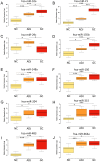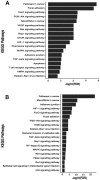Epigenetic Field Cancerization in Gastric Cancer: microRNAs as Promising Biomarkers
- PMID: 31031866
- PMCID: PMC6485221
- DOI: 10.7150/jca.27457
Epigenetic Field Cancerization in Gastric Cancer: microRNAs as Promising Biomarkers
Abstract
Background: The biological role of microRNAs (miRNAs) in field cancerization is unknown. To investigate the involvement of miRNAs in gastric field cancerization, we evaluated the expression profile of ten miRNAs and their diagnostic value. Methods: We used three groups of FFPE gastric samples: non-cancer (NC), cancer adjacent (ADJ) and gastric cancer (GC). The expression profiles of hsa-miR-10a, -miR-21, -miR-29c, -miR-135b, -miR-148a, -miR-150, -miR-204, -miR-215, -miR-483 and -miR-664a were investigated using qRT-PCR. The results obtained by qRT-PCR were validated in Small RNA-Seq data from the TCGA database. The search for target genes of the studied miRNAs was performed in the miRTarBase public database and miRTargetLink tool, using experimentally validated interactions. In addition, we also performed the functional analysis of these genes using enrichment in KEGG pathways. The potential as biomarker was evaluated using a receiver operating characteristic (ROC) curve and the derived area under the curve (AUC>0.85) analysis. Results: The miRNAs hsa-miR-10a, -miR-21, -miR-135b, hsa-miR-148a, -miR-150, -miR-215, -miR-204, -miR-483 and -miR-664a were up-regulated in ADJ and GC compared to NC (P<0.03); and hsa-miR-21 and -miR-135b were up-regulated in GC compared to ADJ (P<0.01). Hsa-miR-148a, -miR-150, -miR-215, -miR-483 and -miR-664a were not differentially expressed between GC and ADJ, suggesting that both share similar changes (P>0.1). The TS-miR hsa-miR-29c was up-regulated in ADJ compared to NC and GC (P<0.01); we did not observe a significant difference in the expression of this miRNA between NC and GC. This feature may be an antitumor mechanism used by cancer-adjacent tissue because this miRNA regulates the BCL-2, CDC42 and DMNT3A oncogenes. The expression level of hsa-miR-204 was associated with Helicobacter pylori infection status (P<0.05). Functional analysis using the genes regulated by the studied miRNAs showed that they are involved in biological pathways and cellular processes that are critical for the establishment of H. pylori infection and for the onset, development and progression of GC. hsa-miR-10a, -miR-21, -miR-135b, -miR-148a, -miR-150, -miR-215, -miR-483 and -miR-664a were able to discriminate NC from other tissues with great accuracy (AUC>0.85). Conclusion: The studied miRNAs are closely related to field cancerization, regulate genes important for gastric carcinogenesis and can be potentially useful as biomarkers in GC.
Keywords: biomarker; epigenetic; field cancerization; gastric cancer; miRNA.
Conflict of interest statement
Competing Interests: The authors have declared that no competing interest exists.
Figures






Similar articles
-
hsa-miR-29c and hsa-miR-135b differential expression as potential biomarker of gastric carcinogenesis.World J Gastroenterol. 2016 Feb 14;22(6):2060-70. doi: 10.3748/wjg.v22.i6.2060. World J Gastroenterol. 2016. PMID: 26877610 Free PMC article.
-
miRNome Reveals New Insights Into the Molecular Biology of Field Cancerization in Gastric Cancer.Front Genet. 2019 Jun 19;10:592. doi: 10.3389/fgene.2019.00592. eCollection 2019. Front Genet. 2019. PMID: 31275362 Free PMC article.
-
APC gene is modulated by hsa-miR-135b-5p in both diffuse and intestinal gastric cancer subtypes.BMC Cancer. 2018 Oct 30;18(1):1055. doi: 10.1186/s12885-018-4980-7. BMC Cancer. 2018. PMID: 30376837 Free PMC article.
-
MicroRNAs expression profiles as diagnostic biomarkers of gastric cancer: a systematic literature review.Biomarkers. 2019 Mar;24(2):110-119. doi: 10.1080/1354750X.2018.1539765. Epub 2018 Nov 15. Biomarkers. 2019. PMID: 30387681
-
Gastric Cancer MicroRNAs Meta-signature.Int J Mol Cell Med. 2019 Spring;8(2):94-102. doi: 10.22088/IJMCM.BUMS.8.2.94. Epub 2019 Aug 24. Int J Mol Cell Med. 2019. PMID: 32215261 Free PMC article. Review.
Cited by
-
RNA-Seq Revealed Novel Non-proliferative Retinopathy Specific Circulating MiRNAs in T2DM Patients.Front Genet. 2019 Jun 4;10:531. doi: 10.3389/fgene.2019.00531. eCollection 2019. Front Genet. 2019. PMID: 31275351 Free PMC article.
-
Global Analyses of Expressed Piwi-Interacting RNAs in Gastric Cancer.Int J Mol Sci. 2020 Oct 16;21(20):7656. doi: 10.3390/ijms21207656. Int J Mol Sci. 2020. PMID: 33081152 Free PMC article.
-
The Expression, Functions and Mechanisms of Circular RNAs in Gynecological Cancers.Cancers (Basel). 2020 Jun 4;12(6):1472. doi: 10.3390/cancers12061472. Cancers (Basel). 2020. PMID: 32512912 Free PMC article. Review.
-
A Nine-Gene Signature for Predicting the Response to Preoperative Chemoradiotherapy in Patients with Locally Advanced Rectal Cancer.Cancers (Basel). 2020 Mar 26;12(4):800. doi: 10.3390/cancers12040800. Cancers (Basel). 2020. PMID: 32225122 Free PMC article.
-
Vitamin D-regulated miRNA expression in tumoral and normal adjacent tissue of localized gastric cancer patients: the impact on survival and time to relapse.Transl Cancer Res. 2025 Jun 30;14(6):3702-3713. doi: 10.21037/tcr-24-2068. Epub 2025 Jun 27. Transl Cancer Res. 2025. PMID: 40687227 Free PMC article.
References
-
- Ferlay J, Soerjomataram I, Dikshit R. et al. Cancer incidence and mortality worldwide: sources, methods and major patterns in GLOBOCAN 2012. Int J Cancer. 2015;136:E359–86. - PubMed
-
- Alfaro EE, Lauwers GY. Early gastric neoplasia: diagnosis and implications. Adv Anat Pathol. 2011;18:268–80. - PubMed
-
- Yakirevich E, Resnick MB. Pathology of gastric cancer and its precursor lesions. Gastroenterol Clin North Am. 2013;42:261–84. - PubMed
-
- Papachristou DN, Fortner JG. Local recurrence of gastric adenocarcinomas after gastrectomy. J Surg Oncol. 1981;18:47–53. - PubMed
LinkOut - more resources
Full Text Sources
Miscellaneous

